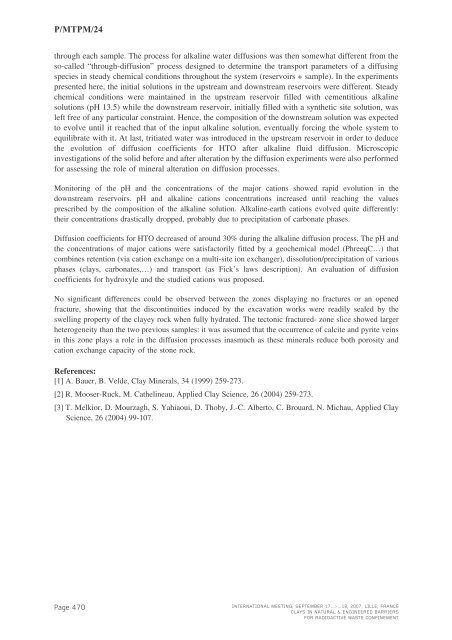P/<strong>MTPM</strong>/24through each sample. The process for alkaline water diffusions was then somewhat different from theso-called “through-diffusion” process designed to determine the transport parameters of a diffusingspecies in steady chemical conditions throughout the system (reservoirs + sample). In the experimentspresented here, the initial solutions in the upstream and downstream reservoirs were different. Steadychemical conditions were maintained in the upstream reservoir filled with cementitious alkalinesolutions (pH 13.5) while the downstream reservoir, initially filled with a synthetic site solution, wasleft free of any particular constraint. Hence, the composition of the downstream solution was expectedto evolve until it reached that of the input alkaline solution, eventually forcing the whole system toequilibrate with it. At last, tritiated water was introduced in the upstream reservoir in order to deducethe evolution of diffusion coefficients for HTO after alkaline fluid diffusion. Microscopicinvestigations of the solid before and after alteration by the diffusion experiments were also performedfor assessing the role of mineral alteration on diffusion processes.Monitoring of the pH and the concentrations of the major cations showed rapid evolution in thedownstream reservoirs. pH and alkaline cations concentrations increased until reaching the valuesprescribed by the composition of the alkaline solution. Alkaline-earth cations evolved quite differently:their concentrations drastically dropped, probably due to precipitation of carbonate phases.Diffusion coefficients for HTO decreased of around 30% during the alkaline diffusion process. The pH andthe concentrations of major cations were satisfactorily fitted by a geochemical model (PhreeqC…) thatcombines retention (via cation exchange on a multi-site ion exchanger), dissolution/precipitation of variousphases (clays, carbonates,…) and transport (as Fick’s laws description). An evaluation of diffusioncoefficients for hydroxyle and the studied cations was proposed.No significant differences could be observed between the zones displaying no fractures or an openedfracture, showing that the discontinuities induced by the excavation works were readily sealed by theswelling property of the clayey rock when fully hydrated. The tectonic fractured- zone slice showed largerheterogeneity than the two previous samples: it was assumed that the occurrence of calcite and pyrite veinsin this zone plays a role in the diffusion processes inasmuch as these minerals reduce both porosity andcation exchange capacity of the stone rock.References:[1] A. Bauer, B. Velde, Clay Minerals, 34 (1999) 259-273.[2] R. Mooser-Ruck, M. Cathelineau, Applied Clay Science, 26 (2004) 259-273.[3] T. Melkior, D. Mourzagh, S. Yahiaoui, D. Thoby, J.-C. Alberto, C. Brouard, N. Michau, Applied ClayScience, 26 (2004) 99-107.Page 470INTERNATIONAL MEETING, SEPTEMBER 17...>...18, 2007, LILLE, FRANCECLAYS IN NATURAL & ENGINEERED BARRIERSFOR RADIOACTIVE WASTE CONFINEMENT
P/<strong>MTPM</strong>/25REACTIVE TRANSPORT MODELLINGOF IN SITU CEMENT/CLAY INTERACTIONSON TOURNEMIRE ARGILLITEF. Marsal 1 , L. De Windt 2 , E. Tinseau 3 , D. Pellegrini 11. IRSN, DSU/SSD/BECS, B.P. 17, 92262 Fontenay-aux-Roses Cedex, France2. Centre de Géosciences - Ecole des Mines de Paris, 77305 Fontainebleau cedex, France3. IRSN, DEI/SARG/LETS, B.P. 17, 92262 Fontenay-aux-Roses Cedex, FranceCONTEXT AND OBJECTIVESDisposal concepts currently developed in France to host long-lived high-level radioactive waste containlarge amounts of cementitious materials. The cement matrix is in strong disequilibrium with thegeochemical conditions which prevail in the argillaceous host rock. IRSN has developed an experimentalprogram, which includes the characterisation of so called “engineered analogues” sampled at theTournemire tunnel site (France), in order to evaluate the perturbations of clays due to the presence ofconcrete. Argillite samples which experienced 15 years of cement/clay interactions were collected in thatpurpose by overcoring a vertical borehole sealed by concrete. The upper part of the borehole (sampledbetween 1 m and 1.30 m in depth), which intersects the EDZ of the main tunnel is slowly drained by waterseeping from a small canal located under the tunnel roadbed. The lower part of the borehole (sampledbetween 1.55 m and 2.60 m) is more representative of argillite/concrete interactions in confined conditions.The aim of the present modelling study is to simulate the main observations made by a first characterisationstage (Tinseau et al., 2006), which has notably highlighted several fronts of perturbations as well as apotential influence of microstructures as preferential pathways. The microstructures are either unloadingjoints of the tunnel EDZ or cracks parallel to the bedding all along the borehole. Recent andcomplementary experimental observations are also discussed in an associated communication at thisconference (see Tinseau et al., 2007). Topical background questions concern the balance between kinetic(time-dependent) mechanisms versus local equilibrium reactions and the effects of cement/clay interactionson micro-texture and transport parameters (e.g. crack clogging).MODELLING FEATURESThe CEM II concrete, which fills the borehole, was modelled by a mixture of 35% Portland cement phases(CSH, sulfo-aluminates and CSH) and 65% calcareous aggregates (calcite) by weight. The interstitial wateris a K–Na–OH fluid of pH 13.2 (at 15°C, the average temperature within the tunnel). The argillite in itsunperturbed state has a high content in clay minerals, mainly illite (22.5%), interstratified illite/smectite(20%) and kaolinite (12.5%); quartz (27%), K-feldspar (5%), calcite (9.5%), dolomite (0.5%) and pyrite(3%) were also taken into account in the simulations. The pore water has a pH of 8.3 with sodium, chlorideand bicarbonate as major ions.The reactive transport code HYTEC (van der Lee et al., 2003) was used to simulate the perturbation of theargillite around the borehole, considering diffusive transport of solutes and chemical reactions (aqueouschemistry and dissolution/precipitation). An explicit representation of the argillite cracks was found to bemore appropriate than a dual porosity approach to investigate the precipitation reactions taking place insidethe cracks and the coupling with the argillite matrix alteration. Effective diffusion coefficient values werefixed in a first step of the modelling, then updated with respect to the calculated local porosity change toassess the sealing process. A time-dependent, kinetic formulation was introduced for all dissolution andprecipitation reactions. This kinetic formulation depends on the saturation state of minerals, pH and oxygencontent (the later, for pyrite oxidation only). The intrinsic rate constants were taken from literature (e.g.Savage et al., 2002). In addition, a sensitivity analysis was performed to the reactive surface areas as wellas to rate constants.INTERNATIONAL MEETING, SEPTEMBER 17...>...18, 2007, LILLE, FRANCECLAYS IN NATURAL & ENGINEERED BARRIERSFOR RADIOACTIVE WASTE CONFINEMENTPage 471
















